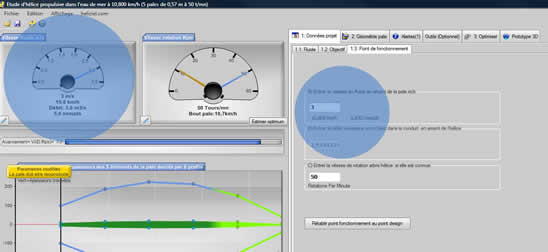Understand and master the propeller and turbine relative fluid speed:
The speed of the fluid taken into account when calculating the performance and design a propeller or a wing,is the upstream flow speed, measured sufficiently far from the propeller or the wing, to detect no disturbance.
In the propellers or turbine calculation formulas, this speed of an undisturbed fluid is called "speed at infinity upstream".
- Example: For a propeller or a wing fitted to a moving vehicle, this speed is that of the vehicle.
The speed of the fluid or vehicle is generally a given in the specifications of the propeller or wing. For a wing, speed depends on the power available to overcome drag. We will then carry out speed tests and the drag and lift force will determine if our wing is correctly sized.
- For propulsion propeller,the speed is determined by the speed of the vehicle,
- For a fan, it is the flow rate of the duct ,
- for a wind turbine it is the average wind speed
- for a tidal or axial turbine it is the speed of the the water flow.
In the propellers calculation software Heliciel, Changing the velocity of the fluid upstream of the propeller wing or can be made either by dragging the pointer from speedometer, either by typing directly in the Project data> Operating Point tab

The speed received by the profiles of the turbine blade, the propeller airplane, or boat, is different from the speed of the fluid far upstream. The rotation of the propeller or rotor blade creates a tangential velocity.The apparent speed perceived by the blade profiles is a composition of the speed of rotation and the speed of the fluid.
Another phenomenon alters the perceived speed of the profile: The induced velocity.The calculation of the performance of a wing or propeller is in large part to define the induced velocities. Calculating the speed induced along the blade, used to establish the angle of incidence of the profile, and hence the performance of the propeller.

 Global site map
Global site map Mecaflux
Mecaflux Tutorials Mecaflux Pro3D
Tutorials Mecaflux Pro3D Tutorials Heliciel
Tutorials Heliciel Mecaflux Store
Mecaflux Store Compare software functions
Compare software functions Quotes, Orders, Payment Methods
Quotes, Orders, Payment Methods project technical studies
project technical studies